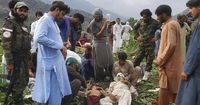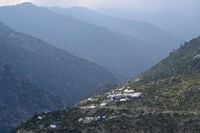In the aftermath of the devastating 6.0-magnitude earthquake that rocked eastern Afghanistan on August 31, 2025, the country faces a monumental challenge: a race against time to clear the staggering 649,000 tonnes of debris and begin the long road to recovery. According to the United Nations Development Programme (UNDP), the catastrophe killed nearly 2,200 people, forced at least 23,000 to flee their homes, and left entire communities in ruins across the mountainous provinces of Kunar, Nangarhar, and Laghman.
For many Afghans, the earthquake struck with little warning late at night, toppling low-rise buildings made mostly of mud, wood, or rocks. These homes, which had long withstood the elements, became instant death traps as they collapsed under the tremors. The destruction was so extensive that satellite data now estimate roughly 40,500 truckloads of debris still litter the affected areas, a figure that underscores the scale of the disaster and the challenge ahead for aid workers and local authorities.
The quake’s epicenter lay deep in the rugged terrain of Kunar province, a region already notorious for its inaccessibility. The Independent reports that the area’s remote geography severely hampered rescue and relief operations. With roads blocked or nonexistent, authorities were forced to deploy helicopters and airdrop army commandos to evacuate survivors. Aid workers, meanwhile, trekked for hours on foot, braving treacherous mountain paths to reach isolated villages where help was desperately needed.
“This is a race against time,” said Devanand Ramiah of the UNDP’s Crisis Bureau, as quoted in multiple outlets. “Debris removal and reconstruction operations must start safely and swiftly.” The urgency is palpable, not just because of the sheer volume of rubble, but because thousands of families remain exposed to the elements, sleeping in the open as they await assistance. Stephen Rodriques, the UNDP’s Afghanistan representative, described the situation as “heartbreaking.” He added, “Families are sleeping in the open, and access to basic services is severely disrupted. We must act quickly to restore dignity and safety.”
The United Nations’ analysis of satellite imagery paints a sobering picture of the disaster’s reach. Nearly 246,000 buildings—including homes, schools, and clinics—lie within the high-impact zones, and 462 kilometers of electric grid lines are at risk. AI-based modeling predicts that between 23,000 and 31,000 people have been internally displaced by the earthquake, with vulnerable populations especially hard hit: approximately 633,000 women, 606,000 children, and 33,000 elderly people were exposed to the disaster’s immediate aftermath.
As the dust settles, the demands of survivors have become clear. Zia ur Rahman Speenghar, a spokesperson for a Taliban government committee tasked with assisting survivors, told the Associated Press that the main priorities are the reconstruction of homes and restoration of water supplies. “Various countries and organizations have offered assistance in the construction of houses but that takes time. After the second round of assistance, work will begin on the third round, which is considering what kind of houses can be built here,” Speenghar said. In the meantime, people are receiving immediate relief in the form of cash, food, tents, beds, and other basic necessities.
Despite these efforts, the logistical hurdles remain immense. The UNDP and other humanitarian agencies are using satellite-based data to identify and prioritize the most impacted areas for debris clearance, structural assessments, and restoring access. Three new roads are currently under construction in Dewagal Valley, with plans to build routes to areas that were previously inaccessible—a critical step for delivering aid and beginning reconstruction in earnest.
The sense of urgency is heightened by Afghanistan’s broader context of crisis. Roza Otunbayeva, head of the UN mission to Afghanistan, described the country as facing a “perfect storm” of challenges. In addition to natural disasters like the recent earthquake, Afghanistan is grappling with aid cuts, a struggling economy, climate-related stressors, and significant population returns from neighboring countries. At a UN Security Council briefing on September 17, Otunbayeva emphasized that the development of Afghanistan’s full potential is essential for addressing these interconnected crises.
The difficulties faced by emergency workers in the immediate aftermath of the quake cannot be overstated. According to BBC and other outlets, many aid workers had to walk for hours on foot to reach the worst-hit communities in Kunar province. The mountainous terrain, combined with the destruction of existing roads, meant that isolated villages were cut off from help for days. As a result, the initial focus was on evacuating survivors and providing life-saving assistance, but the need for long-term recovery and rebuilding has quickly taken center stage.
While international assistance has begun to trickle in, the process of rebuilding will be slow. The UNDP and other agencies are collaborating with the Taliban government and local organizations to assess what kinds of houses can be built to better withstand future disasters. The hope is that, with careful planning and international support, new homes and infrastructure can be constructed that are more resilient than those that came before.
Still, for those living in the shadow of the earthquake, daily life remains a struggle. Access to basic services such as clean water, electricity, and healthcare is severely disrupted. Schools and clinics have been damaged or destroyed, and the risk of disease and further hardship looms large for families sleeping outdoors.
As the world’s attention turns to other crises, Afghanistan’s earthquake survivors are left hoping that the “race against time” will not be lost. The scale of the disaster, the vulnerability of the affected populations, and the complexity of the terrain all combine to make this one of the most daunting humanitarian challenges in recent memory. Yet, as aid workers clear rubble and new roads slowly open, there is a glimmer of hope that recovery is possible—if the world continues to pay attention and lend a hand.
For now, the people of eastern Afghanistan wait—determined, resilient, and relying on the promise that help is on the way, even as the clock keeps ticking.





